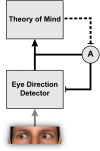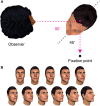Adaptation to the Direction of Others' Gaze: A Review
- PMID: 30473675
- PMCID: PMC6237883
- DOI: 10.3389/fpsyg.2018.02165
Adaptation to the Direction of Others' Gaze: A Review
Abstract
The direction of another person's gaze provides us with a strong cue to their intentions and future actions, and, correspondingly, the human visual system has evolved to extract information about others' gaze from the sensory stream. The perception of gaze is a remarkably plastic process: adaptation to a particular direction of gaze over a matter of seconds or minutes can cause marked aftereffects in our sense of where other people are looking. In this review, we first discuss the measurement, specificity, and neural correlates of gaze aftereffects. We then examine how studies that have explored the perceptual and neural determinants of gaze aftereffects have provided key insights into the nature of how other people's gaze direction is represented within the visual hierarchy. This includes the level of perceptual representation of gaze direction (e.g., relating to integrated vs. local facial features) and the interaction of this system with higher-level social-cognitive functions, such as theory of mind. Moreover, computational modeling of data from behavioral studies of gaze adaptation allows us to make inferences about the functional principles that govern the neural encoding of gaze direction. This in turn provides a foundation for testing computational theories of neuropsychiatric conditions in which gaze processing is compromised, such as autism.
Keywords: face perception; gaze direction; sensory coding; social attention; visual adaptation.
Figures





Similar articles
-
Spatial selectivity in adaptation to gaze direction.Proc Biol Sci. 2022 Aug 10;289(1980):20221230. doi: 10.1098/rspb.2022.1230. Epub 2022 Aug 10. Proc Biol Sci. 2022. PMID: 35946160 Free PMC article.
-
The visual system encodes others' direction of gaze in a first-person frame of reference.Cognition. 2017 Nov;168:256-266. doi: 10.1016/j.cognition.2017.07.007. Epub 2017 Jul 21. Cognition. 2017. PMID: 28735177
-
Functional Mechanisms Encoding Others' Direction of Gaze in the Human Nervous System.J Cogn Neurosci. 2017 Oct;29(10):1725-1738. doi: 10.1162/jocn_a_01150. Epub 2017 May 30. J Cogn Neurosci. 2017. PMID: 28557689
-
Influences of eye gaze cues on memory and its mechanisms: The function and evolution of social attention.Front Psychol. 2022 Oct 14;13:1036530. doi: 10.3389/fpsyg.2022.1036530. eCollection 2022. Front Psychol. 2022. PMID: 36312084 Free PMC article. Review.
-
Facing the gaze of others.Neurophysiol Clin. 2008 Jun;38(3):197-207. doi: 10.1016/j.neucli.2008.03.001. Epub 2008 Apr 11. Neurophysiol Clin. 2008. PMID: 18539254 Review.
Cited by
-
Face identity and facial expression representations with adaptation paradigms: New directions for potential applications.Front Psychol. 2022 Dec 19;13:988497. doi: 10.3389/fpsyg.2022.988497. eCollection 2022. Front Psychol. 2022. PMID: 36600709 Free PMC article. Review.
-
Eye Direction Detection and Perception as Premises of a Social Brain: A Narrative Review of Behavioral and Neural Data.Cogn Affect Behav Neurosci. 2022 Feb;22(1):1-20. doi: 10.3758/s13415-021-00959-w. Epub 2021 Oct 12. Cogn Affect Behav Neurosci. 2022. PMID: 34642895 Review.
-
Not to follow because of distrust: perceived trust modulates the gaze cueing effect.Psychol Res. 2024 Nov;88(8):2195-2210. doi: 10.1007/s00426-024-02000-4. Epub 2024 Jul 3. Psychol Res. 2024. PMID: 38958738
-
Holistic processing of gaze cues during interocular suppression.Sci Rep. 2022 May 11;12(1):7717. doi: 10.1038/s41598-022-11927-w. Sci Rep. 2022. PMID: 35546346 Free PMC article.
-
Spatial selectivity in adaptation to gaze direction.Proc Biol Sci. 2022 Aug 10;289(1980):20221230. doi: 10.1098/rspb.2022.1230. Epub 2022 Aug 10. Proc Biol Sci. 2022. PMID: 35946160 Free PMC article.
References
-
- American Psychiatric Association (2013). Diagnostic and Statistical Manual of Mental Disorders: DSM-5, 5th Edn. Arlington, VA: American Psychiatric Association; 10.1176/appi.books.9780890425596 - DOI
-
- Argyle M., Cook M. (1976). Gaze and Mutual Gaze. Cambridge: Cambridge University Press.
-
- Baron-Cohen S. (1995). Mindblindness: An Essay on Autism and Theory of Mind. Cambridge, MA: MIT Press.
Publication types
LinkOut - more resources
Full Text Sources

